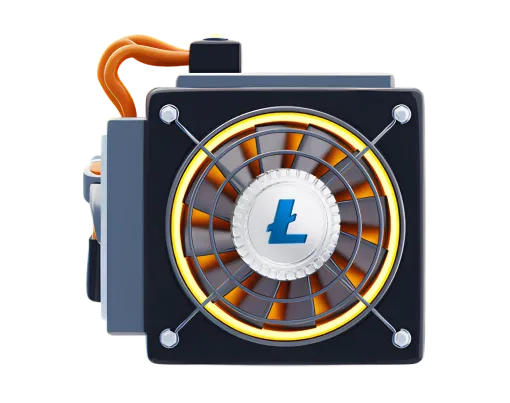How to Mine Litecoin in 2025: An Easy Beginner’s Guide

Litecoin is one of the most popular cryptocurrencies to mine. The mining process involves validating transactions on the Litecoin blockchain, which secures the network and rewards miners with new coins. This guide provides a comprehensive overview of how to mine Litecoin, covering the necessary tools, setup, and best practices for beginners.
What Is Litecoin Mining?
Litecoin mining is the process of using computing power to process transactions and secure the Litecoin network. Miners use specialized hardware, such as Application-Specific Integrated Circuits (ASICs), to solve complex cryptographic puzzles. When a miner successfully solves a puzzle, they get to add the next block of transactions to the blockchain and receive a reward in Litecoin (LTC). This process not only validates transactions but also introduces new coins into circulation.
Is Litecoin Still Worth Mining in 2025?
Mining Litecoin can be a profitable venture in 2025, but its success depends on several factors, including your hardware's efficiency, electricity costs, and the market value of LTC. Beyond potential financial gain, mining contributes to the security and decentralization of the Litecoin network. It also offers a hands-on opportunity to learn about blockchain technology and the inner workings of digital currencies.
Litecoin Mining Methods
Litecoin mining can be approached in two primary ways: solo mining and pool mining.
Solo Mining
Solo mining involves using your own resources to find blocks independently. The main advantage is that you keep the entire block reward if you are successful. However, the probability of finding a block alone is very low due to the network's high difficulty, unless you operate a very large amount of high-performance hardware. This can result in unpredictable and unstable earnings.
Pool Mining
In pool mining, a group of miners combines their computational power to increase the collective chance of finding blocks. When the pool successfully mines a block, the reward is distributed among participants based on their contributed processing power. This method provides a much more stable and predictable stream of income, though pools typically charge a small fee, often 1% to 2% of earnings. Pool mining also has a lower barrier to entry, making it ideal for beginners.
What You Need to Start Mining Litecoin in 2025
To start mining Litecoin, you will need the following essential components:
Litecoin Mining Hardware
An Application-Specific Integrated Circuit (ASIC) miner is the standard for efficient Litecoin mining. ASICs are specialized devices designed specifically for solving the Scrypt algorithm used by Litecoin. While powerful Graphics Processing Units (GPUs) can also be used, they are significantly less effective than modern ASICs. When choosing hardware, consider its hash rate (mining speed), power consumption, and initial cost to find a balance between performance and profitability.
Litecoin Mining Software
Mining software connects your hardware to the Litecoin network or a mining pool. It assigns tasks to your hardware and reports your work back to the network. The software also allows you to monitor key statistics like your hash rate, device temperature, and earnings.
Litecoin Wallet
A secure wallet is necessary to store the LTC you earn. You can choose between a software wallet (like a desktop or mobile app) or a hardware wallet for enhanced security. Always back up your wallet's private keys or seed phrase to protect your assets.
How to Set Up a Litecoin Miner (Step-by-Step)
Here is a step-by-step guide to setting up your LTC mining operation.
Step 1: Choose Your Mining Hardware
Your hardware choice is the most critical factor for profitability. While it's technically possible to use a computer's processor (CPU) or graphics card (GPU), these methods are no longer profitable for Litecoin. An ASIC miner designed for the Scrypt algorithm is the only practical option for serious mining. These machines offer the highest hash rates and efficiency but represent a significant investment and generate considerable heat and noise.
Step 2: Download Compatible Mining Software
Once you have your hardware, you need compatible mining software. ASIC miners often come with pre-installed software or specific recommendations from the manufacturer. If you are using other hardware, popular options include CGMiner, EasyMiner, or MultiMiner. Ensure the software you choose is compatible with both your hardware and your chosen mining pool.
Step 3: Set Up a Wallet to Store Your Litecoin
Before you begin mining, set up a secure wallet to receive your earnings. Choose a reliable cryptocurrency wallet that fits your security needs. Software wallets like Exodus or Trust Wallet are convenient, while hardware wallets from Ledger or Trezor offer superior security for storing significant amounts of crypto.
Step 4: Decide Whether to Join a Pool or Go Solo
As a new miner, you must decide between solo mining and pool mining. Pool mining is highly recommended for almost everyone. Solo mining requires an enormous amount of hashing power to find a block, which can take years or may never happen. Mining pools offer smaller, consistent payouts that make your income more predictable.
Step 5: Join the Litecoin Network via a Mining Pool
If you choose to pool mine, select a reliable and trustworthy pool. Research pools based on their fees, payout methods, server locations, and reputation. Some popular Litecoin pools include LitecoinPool.org, ViaBTC, and F2Pool. After registering, the pool will provide you with a server address and worker details to enter into your mining software configuration.
Step 6: Configure Your Mining Software
Enter the mining pool's server address, your username, and worker password into your mining software. This configuration directs your hardware's hashing power to the pool. Once configured, you can start the software and begin contributing to the pool's efforts.
Step 7: Start Mining
With everything configured, launch your mining software to begin. You can monitor your progress and earnings through your software's interface and the mining pool's dashboard. Keep an eye on your hardware's temperature and performance to ensure it runs smoothly.
Tips for Successful Litecoin Mining
Follow these key tips to maximize your mining efforts in 2025.
- Invest in the Right Hardware: Use modern ASIC miners for the best performance and profitability. CPUs and GPUs are suitable for learning but are not profitable for Litecoin.
- Choose a Reliable Mining Pool: Select a reputable mining pool with low fees, stable payouts, and a good track record to ensure a steady income.
- Secure Your Wallet: Protect your mined Litecoin in a secure wallet. Use features like two-factor authentication and always back up your recovery phrase in a safe place.
- Account for Electricity Costs: Mining hardware consumes significant power. Calculate your electricity costs to ensure your operation remains profitable.
- Monitor Performance and Market Trends: Regularly check your mining performance, Litecoin's price, and network difficulty. Profitability can change quickly based on these factors.
- Maintain Your Equipment: Regularly check your hardware's temperature, fan speeds, and hash rate. Proper cooling and maintenance prevent damage and maximize efficiency.
- Be Patient and Persistent: Mining is a long-term endeavor. Don't expect immediate results. Consistently run your operation and optimize your setup over time for the best returns.
Conclusion
Mining Litecoin in 2025 can be a rewarding experience with the right equipment and strategy. Success depends on making smart choices, from selecting efficient hardware and a reliable mining pool to securing your earnings in a trusted wallet. By following the steps in this guide, you can begin contributing to the Litecoin network and earning cryptocurrency.
Please be advised that this article does not constitute investment advice. You should act at your own risk and, if necessary, seek professional advice before making any investment decisions.

 Roman Klochko
Roman Klochko